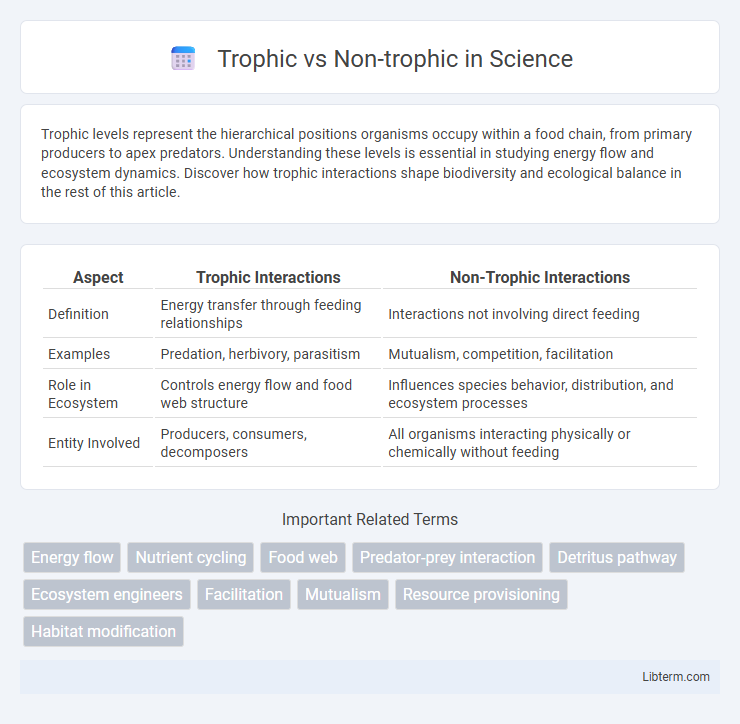Trophic levels represent the hierarchical positions organisms occupy within a food chain, from primary producers to apex predators. Understanding these levels is essential in studying energy flow and ecosystem dynamics. Discover how trophic interactions shape biodiversity and ecological balance in the rest of this article.
Table of Comparison
| Aspect | Trophic Interactions | Non-Trophic Interactions |
|---|---|---|
| Definition | Energy transfer through feeding relationships | Interactions not involving direct feeding |
| Examples | Predation, herbivory, parasitism | Mutualism, competition, facilitation |
| Role in Ecosystem | Controls energy flow and food web structure | Influences species behavior, distribution, and ecosystem processes |
| Entity Involved | Producers, consumers, decomposers | All organisms interacting physically or chemically without feeding |
Introduction to Trophic and Non-Trophic Interactions
Trophic interactions refer to the feeding relationships between organisms, such as predation, herbivory, and parasitism, which drive energy flow within ecosystems. Non-trophic interactions encompass non-feeding relationships like competition, mutualism, and habitat modification that influence species population dynamics and ecosystem structure. Understanding both trophic and non-trophic interactions is essential for comprehensively analyzing ecological networks and biodiversity maintenance.
Defining Trophic Interactions
Trophic interactions refer to the feeding relationships between organisms, where energy and nutrients flow through food chains and food webs, defining predator-prey or herbivore-plant dynamics. Non-trophic interactions, in contrast, involve relationships that do not directly involve consumption, such as mutualism, competition, or habitat modification. Understanding trophic interactions is crucial for analyzing ecosystem structure, energy transfer, and species population dynamics.
Understanding Non-Trophic Interactions
Non-trophic interactions involve relationships between organisms that do not center on feeding or energy transfer, such as mutualism, competition, and habitat modification. These interactions significantly influence ecosystem dynamics by altering species behavior, distribution, and community structure beyond predator-prey or consumer-resource links. Understanding non-trophic interactions is crucial for comprehensive ecosystem modeling and biodiversity conservation strategies.
Key Differences Between Trophic and Non-Trophic Relationships
Trophic relationships involve energy transfer between organisms through feeding interactions, such as predator-prey or herbivore-plant dynamics, which directly influence ecosystem food webs. Non-trophic relationships, in contrast, include interactions that do not involve energy exchange, such as mutualism, commensalism, and competition, affecting population dynamics and species coexistence. The key difference lies in trophic links driving energy flow and biomass transfer, while non-trophic links shape ecological structure through non-feeding interactions.
Ecological Roles of Trophic Interactions
Trophic interactions regulate energy flow and nutrient cycling within ecosystems by linking producers, consumers, and decomposers in a complex food web. These interactions dictate population dynamics, influence community structure, and maintain ecosystem stability through predator-prey relationships, herbivory, and detritivory. Non-trophic interactions, while important, mainly affect species coexistence and habitat modification without directly transferring energy or nutrients.
Ecological Importance of Non-Trophic Interactions
Non-trophic interactions, such as mutualism, competition, and facilitation, play a crucial role in maintaining ecosystem stability and biodiversity by influencing species distributions and community structure beyond direct feeding relationships. These interactions regulate resource availability, habitat complexity, and population dynamics, contributing to resilience against environmental disturbances. Understanding non-trophic relationships enhances ecosystem management strategies by highlighting mechanisms that support ecosystem services and overall ecological health.
Examples of Trophic Interactions in Nature
Trophic interactions in nature involve feeding relationships where energy and nutrients flow from one organism to another, such as predator-prey dynamics between lions and zebras or herbivory where caterpillars consume leaves. These interactions include primary producers like plants converting solar energy through photosynthesis, primary consumers such as rabbits feeding on plants, and secondary consumers like wolves preying on herbivores. Non-trophic interactions contrast by involving relationships such as competition, mutualism, or habitat modification, exemplified by coral providing shelter to fish without direct feeding.
Examples of Non-Trophic Interactions in Ecosystems
Non-trophic interactions in ecosystems include mutualism, such as the relationship between bees and flowering plants where pollination occurs without predation; facilitation, like nurse plants providing shade that assists seedling survival; and interference competition, where species directly hinder each other's access to resources without consuming one another. Physical modifications to habitats by organisms, such as beavers building dams that alter water flow and create new niches, also exemplify non-trophic interactions. These interactions influence community structure, biodiversity, and ecosystem functioning beyond the traditional food web dynamics.
Impacts on Community Structure and Biodiversity
Trophic interactions, such as predation and herbivory, directly influence community structure by controlling population sizes and resource distribution, thereby enhancing biodiversity through niche differentiation. Non-trophic interactions, including habitat modification and competition, affect species coexistence and ecosystem stability by altering environmental conditions and resource availability. Both interaction types crucially shape community dynamics, with trophic effects often driving food web complexity and non-trophic effects mediating habitat heterogeneity and species assemblages.
Trophic vs. Non-Trophic: Implications for Ecosystem Management
Trophic interactions, involving feeding relationships and energy transfer among organisms, are fundamental for maintaining ecosystem structure, stability, and nutrient cycling. Non-trophic interactions, including competition, mutualism, and habitat modification, influence species distribution and community dynamics beyond direct feeding links. Effective ecosystem management requires integrating both trophic and non-trophic factors to promote biodiversity, resilience, and ecosystem services.
Trophic Infographic

 libterm.com
libterm.com